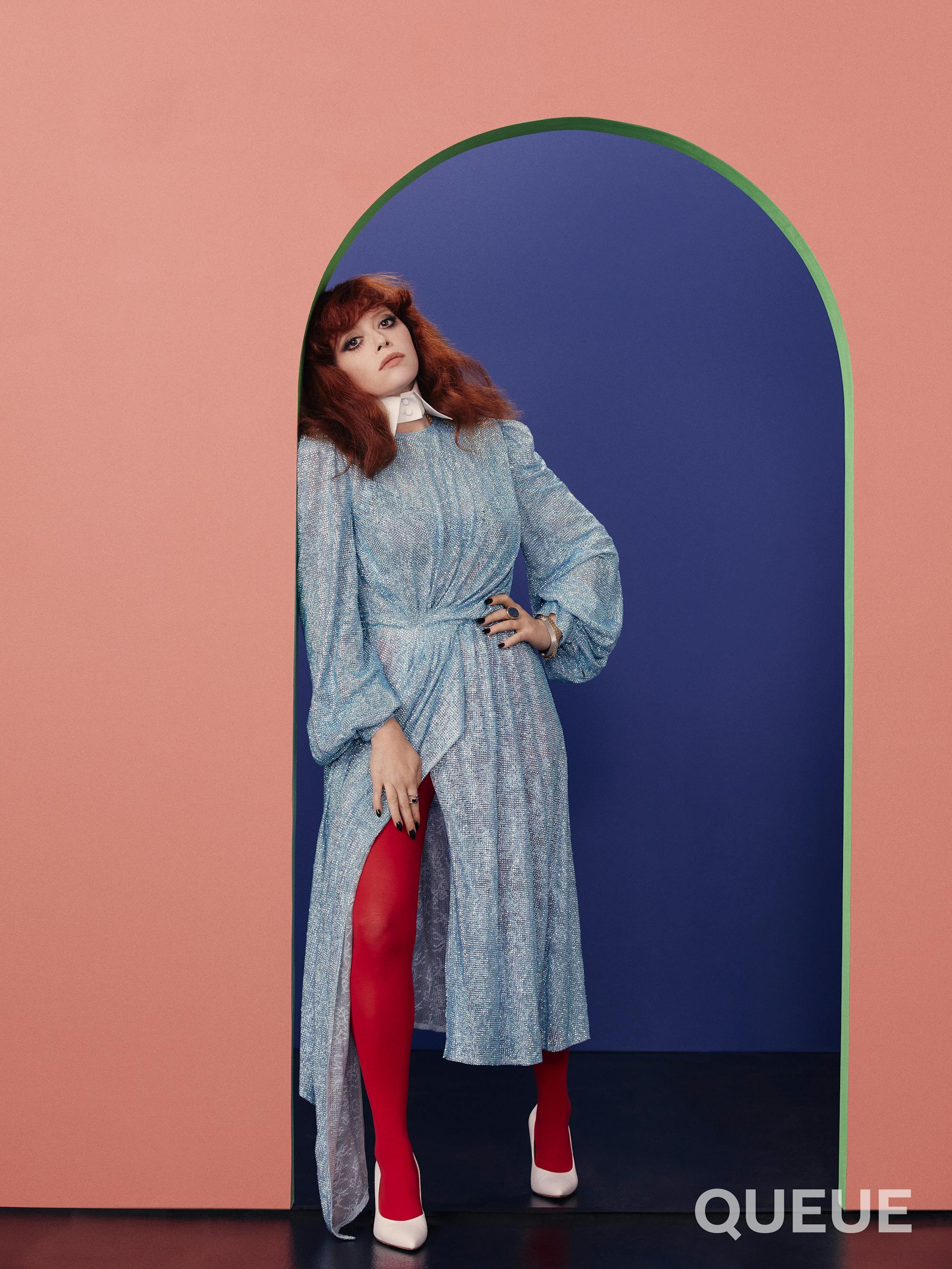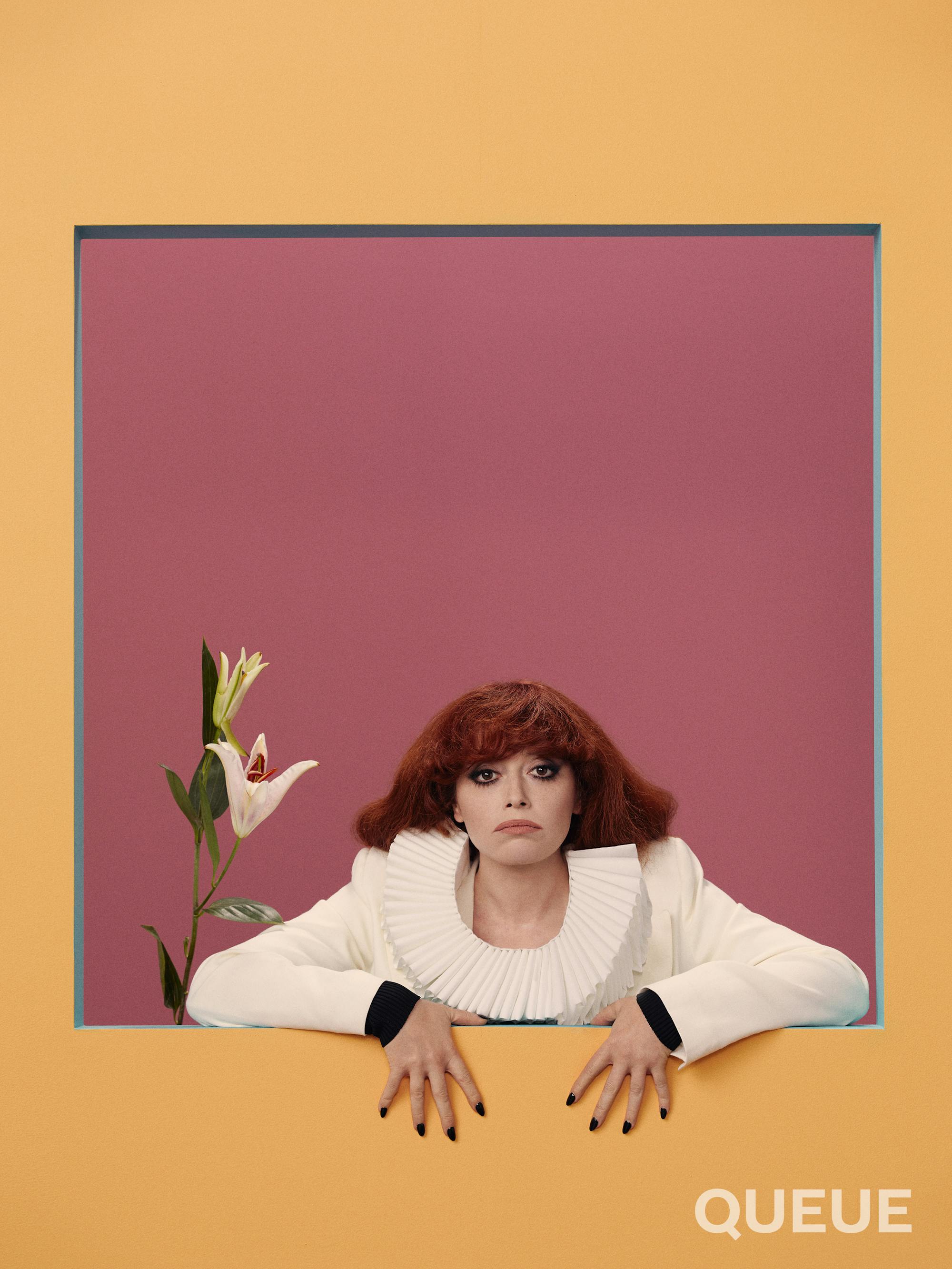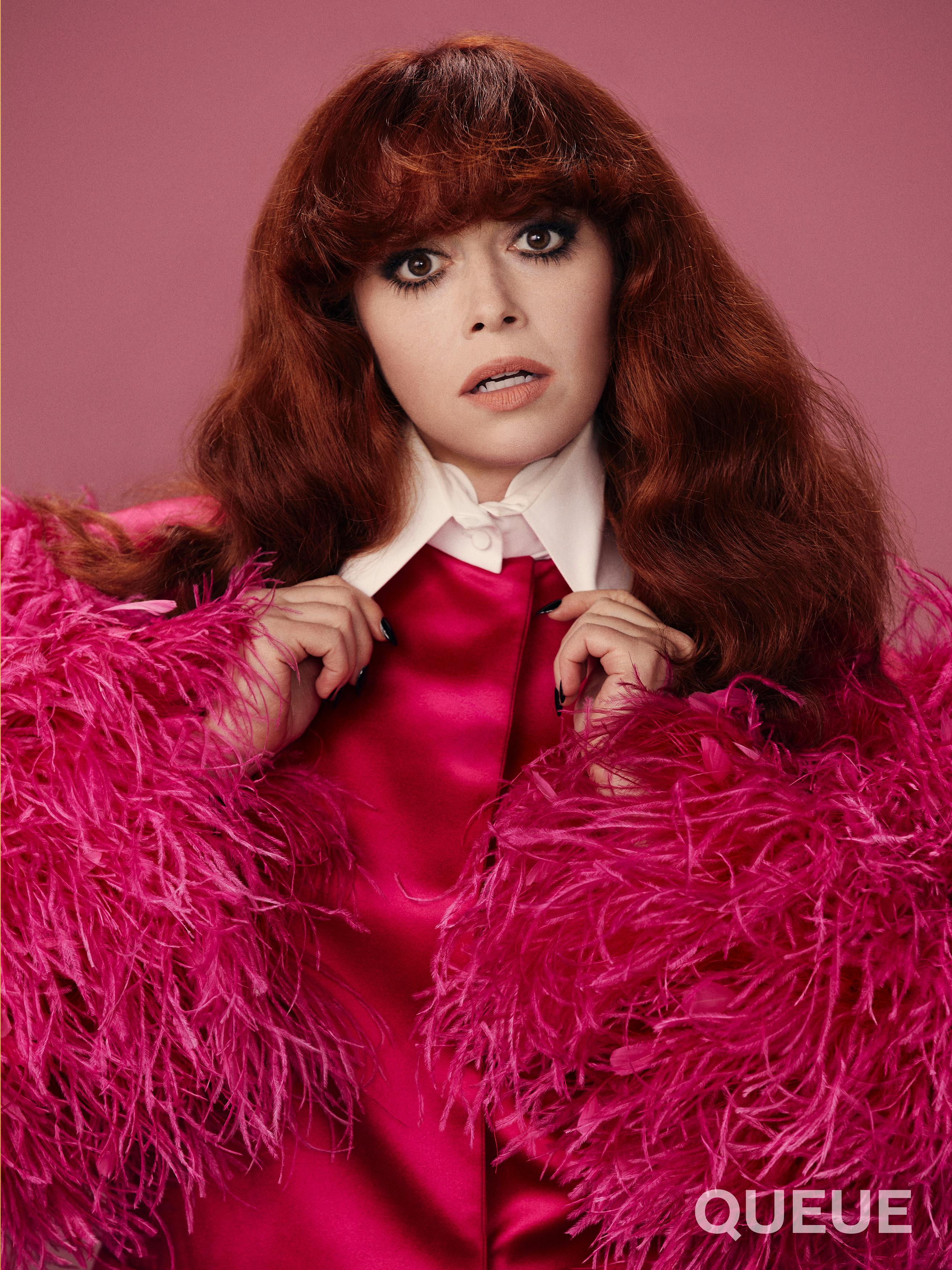Darcie Wilder journeys inside Russian Doll with the show's director and star.
We could’ve said goodbye to Nadia forever. Russian Doll’s first season wrapped up so neatly, so perfectly, that all of it — Nadia’s perpetual deaths, her friendship with time loop companion Alan, the Avenue-B-dive-bar magical realism — could have ended there, a cynic’s ode to sentimentality and nostalgia. But instead, thankfully, creators Natasha Lyonne and Amy Poehler, and executive producer Leslye Headland, have drawn us deeper inside Nadia’s enigmatic world and the Tompkins Square Park extended universe.
I binged Russian Doll Season 2 in one sitting, finding, every so often, parallels to my own life popping up. Some were common enough: life-long New Yorker, bereaved daughter, one-time mood-altering substance enthusiast. Others were a little more eerie: recalling I, too, had an engineer ancestor — who helped build the A-train line, according to family lore — and an odd encounter in the dusty back-room of an Eastern European train station. These serendipities, which at first seemed too-perfect, faded into the grand scheme of the Russian Doll cosmos, as the show pulled me through the repeated Groundhog Day deaths of Nadia (played by Lyonne), down a proverbial, never-ending-set-of-stairs, until she rediscovers her inner child, which bears similarities to Alan’s (Charlie Barnett). Despite being two people whose paths would only cross at 2 a.m. in the bodega line, Nadia and Alan are tethered. Two opposites forced to recognize themselves in the other until they can, in tandem, emerge from the swamp.
Russian Doll picks up with Nadia and Alan exactly three years after the first season ends, on Nadia’s birthday. Our sweet birthday baby is still a bit jolted from her fantastical journey, which no one besides Alan would understand, let alone believe. They keep tabs on each other, checking to make sure the other hasn’t fallen headlong into another snafu in the space-time continuum, finding again that their fates are inextricably linked.
Needless to say, I was very excited to talk to Natasha Lyonne about the densely woven, metaphysical world she’s created.

Darcie Wilder: How did you conceptualize Season 2? Was it already fleshed out when you created the series, or was it built upon having already produced the first season of Russian Doll?
Natasha Lyonne: We always had a sense that the show would be somewhat continuous, but also anthological, and we had thought about setting a season around Tompkins Square Park in the eighties. While pitching the show back in the day, we had all these wild ideas. It’s almost funny to look back at that and see which threads survived. After we completed the writer’s room [for Season 2], during the COVID shutdown, I began rewriting with a smaller team. But as we dug in, the story kind of took itself on its own journeys. And [the process of writing] was like chasing it.
A creator is lucky enough to find this very narrow window where they’re actually allowed to do anything that they can think of. In my case, I really felt like: Well, gosh, I want to take that window. The goal was to take a big swing. I knew that I wanted this season to be a new direction and a reset. Conceptually, the show is very mercurial in the writing and editing, and even in shooting. It expands and contracts; it can feel either too surreal or too serious or too silly. The funny thing about the second season is that it was really like having to rebuild that learning curve all over again. There was so much information that we didn’t know that we had to invent from scratch. The events of Season 1 take place almost in one night, in one location, and with this very recurring cast of characters. So, it’s just a very different game.
Was there anything specific that you tried to capture about 1982 in the East Village? The Guardian Angels were a huge thing; what other particularities were you drawn to?
NL: In part, it was a math game, working backwards from several events of Season 1 — Nadia’s birthday, the minting of the Krugerrand, and World War II — there were a few dates that we had to hit that led to landing on 1982. For Alan’s storyline as well, the math had to make sense. In general, I love that era of New York and the East Village and the music. And it’s funny that Russian Doll has a bit of a New Wave flare to it naturally, for some reason.
Movies like Streets of New York, The King of Comedy, After Hours, and Taxi Driver are very obviously versions of Russian Doll’s New York. We based the show on [Robert] Altman’s The Long Goodbye and Elliott Gould’s Philip Marlowe. The origin of Oatmeal [the cat] is very much Elliott Gould’s cat in The Long Goodbye. There are so many references that we play around with, like Midnight Cowboy. Obviously The Taking of Pelham One Two Three is all over this season. It’s a very fun era.

The generational trauma that Nadia works through seems spiritually and creatively exhausting at the same time. Were there any therapeutic or spiritual concepts that helped you navigate that?
NL: There are also quite a few scientific concepts because the show always likes a measure of mathiness. The evidence of science lends itself to the ridiculous more than the therapeutic aspect on some level. That pairs really well with the philosophical, therapeutic, and spiritual journeys that I’ve been on as a person who’s had to clean up their act. A more practical application of that idea is in resentment or regret with trauma.
It’s like: You can walk into a room and the smell, or the way somebody looks at you, can trigger a moment in your childhood. You don’t even know how you got there, but you just time traveled. Suddenly you’re closed off and turning this neutral interaction into something loaded, and you’re in your head about it. It’s involuntary. We’re all survivors, whether it was a bad breakup, or your fucking mom locked you in the closet, like in Carrie.
I would say I only have a topical understanding of these things. But even like, everything we know from a Buddhist standpoint is about an inability to be here. Well, Where is here? is the kind of question that I like to bring to the writer’s room. So, I think of ideas that would draw connections. Amy Poehler will always say [that] it’s about getting to like your littlest self. For Alan and Nadia, it’s getting to some innermost self that they can be honest with, and then be able to look at themselves in the mirror. The show is obviously so much about that as a philosophical trope.
What was it like fleshing out Alan’s storyline and working with actor Charlie Barnett this season?
NL: I just love Charlie so much, as a human being. And I think because Chloë [Sevigny] and I are essentially sisters at this point, it was really important to me that Charlie also have that familial connection. So, I brought him in on all that. Each step of the way, Charlie [offered suggestions for Alan’s story], and he always wanted it to even go further. I think we share a desire [for creating] something really complex and trying to help other people feel seen through storytelling. That’s really important to both of us.
We all hope that our shows are prestigious and people like and take them seriously and they spark something for people. But ultimately, Charlie, Leslye [Headland], Amy [Poehler] and Alex Buono, the producing director this season, and I all have a deeper desire to [create something] for kids who are a little bit off center, something that makes them feel a little less alone.

The show has a very nuanced depiction of mental illness, which was done in a careful way.
NL: It’s kind of like everyone’s got their own bag of rocks to tow in the show. But there’s a comfort in being like, “Hey look, I’m not going to put anything in here I didn’t see at home.” That was the litmus test. Because it is so tricky — when we start talking about trauma and mental illness — to portray it sensitively. Life is complex. It’s so wild for me whenever I see Chloë playing [Nadia’s mother] Lenora. In my life, Chloë’s like my big sister, she’s like the safest person I have. The way Chloë’s skin smells when she’s stroking my head because I’m crying — I’m like, “Oh, I’m at home.” Chloë has never been late to anything her entire fucking life. My mother has done nothing but miss flights her whole life. I think that I find real comfort in [Chloë]’s exactitude. I know where she’s going to be. It’s always when I’m watching her in the edit that it really hits me — she always makes me cry.
For me — and I’m sure pretty much everybody else on the planet — a mother is a triggering figure. So, it’s like watching the ghost of my mom enter the safest person I have, then watching it onscreen. For anyone who has had a mentally ill parent, it’s a very complex relationship. I guess this is a long way of saying that I love my mother so much. It kills me that she struggled and I spent a lot of time trying to get her help.
Chloë also does a beautiful job of bringing just the right amount of nuance. When people are untreated, there is something almost addictive about them in their chaos, or they can be incredibly charismatic. Hopefully this show reflects the heartbreaks and joys of that.
This season there’s also a Romani character who survived the Holocaust, which is very noteworthy and rare to see.
NL: Delia was a really important character to us and also continued this thread of female friendships. [Nadia’s grandmother] Vera and Delia have been through this war together as outsiders and make it to the States together finally and live in the same building in the East Village in New York. Then you get to this next generation, which is [Nadia’s mother] Lenora and [Nadia’s godmother] Ruth. And they go through a whole life of female friendship together. And then you get to Nadia and Maxine. There’s just something very sweet to me about the fact that, again and again, this is how we make it through life.
What has Russian Doll meant for you?
NL: This season was so much fun and it’s so much work. You want to make sure everybody is staying healthy, and you’re waking up in the middle of the night in a cold sweat, like, “Oh shit, we’ve got the story wrong. This is the story.” There’s this constant adrenaline stress. But there were days I would just walk onto that set and be hit with a wave of such intense gratitude, I just couldn’t believe that we have this show, and everybody is working. I went to dinner with our department heads and I started crying like a fucking baby because I was just so grateful. I was so moved that everybody stayed in the fight. It was supposed to be nine months from start to finish, and it ended up being three years. And, somehow, we did it.
